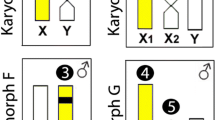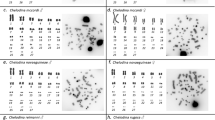Abstract
In this work, genomic in-situ hybridization (GISH) was used to study the sex chromosome molecular differentiation on chromosomes of male and female individuals of the isopod crustacean Asellus aquaticus. As a composite hybridization probe, we contemporaneously used male and female whole genomic DNA differently labelled in the presence of an excess of unlabelled DNA of the female homogametic sex. The karyotype of A. aquaticus normally displays eight homomorphic chromosome pairs, but a heteromorphic sex chromosome pair is present in about a quarter of the males of a natural population previously identified by us. GISH did not reveal any sex chromosome molecular differentiation on the male and female homomorphic sex chromosome pair, and the karyotypes of these individuals were equally labelled by the male- and female-derived probe, while the heteromorphic Y chromosome showed a differentially labelled region only with the male-derived probe. This region evidently contains male-specific sequences but, because no similar hybridized region is observed on the male homomorphic chromosome pair, they are probably not important for sex determination but represent a molecular differentiation acquired from the Y chromosome.
Similar content being viewed by others
References
Barzotti R, Pelliccia F, Rocchi A (1996) Heterochromatin and ribosomal genes in Asellus aquaticus (Crust. Isop.). Chromosome Res 4: 177-181.
Barzotti R, Pelliccia F, Rocchi A (1997) Longitudinal differentiation of chromosomes of Asellus aquaticus (Crust. Isop.) by in situ nick translation using restriction enzymes and DNase I. Chromosome Res 5: 521-526.
Lucchesi JC (1999) On the origin of sex chromosomes. BioEssay 21: 188-190.
Regaud T, Juchault P, Mocquard J-P (1997) The evolution of sex determination in isopod crustaceans. BioEssay 19: 409-416.
Rocchi A, Prantera G, Lanza V, Di Castro M (1984) Incipient sex chromosome differentiation in an isopod crustacean species, Asellus aquaticus. Chromosoma 89: 193-196.
Steinemann M, Steinemann S, Lottspeich F (1993) How Y chromosomes become genetically inert. Proc Natl Acad Sci USA 90: 5737-5741.
Traut W, Sahara K, Otto TD, Marec F (1999) Molecular differentiation of sex chromosomes probed by comparative genomic hybridization. Chromosoma 108: 173-180.
Volpi EV, Pelliccia F, Lanza V, Di Castro M, Rocchi A (1992) Morphological differentiation of a sex chromosome and ribosomal genes in Asellus aquaticus (Crust. Isop.). Heredity 69: 478-482.
Volpi EV, Pelliccia F, Lanza V, Barzotti R, Rocchi A (1995) Simple DNA repeats and sex chromosome differentiation in Asellus aquaticus (Crustacea, Isopoda). Heredity 75: 267-272.
Author information
Authors and Affiliations
Rights and permissions
About this article
Cite this article
Barzotti, R., Pelliccia, F. & Rocchi, A. Sex chromosome differentiation revealed by genomic in-situ hybridization. Chromosome Res 8, 459–464 (2000). https://doi.org/10.1023/A:1009246520601
Issue Date:
DOI: https://doi.org/10.1023/A:1009246520601




